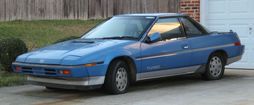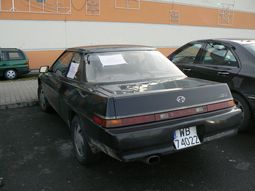The History Of Subaru Alcyone

The Subaru XT, XT6, Vortex, and Alcyone was a sporty 2-door coupé that was sold from 1985 to 1991. The name Alcyone was used in Japan, the Vortex name was used in Australia and New Zealand, and the name XT (with the four cylinder EA82 engine) or XT6 (using the ER27 six cylinder engine), was sold in North America and Europe. All were available in front-wheel drive or four-wheel drive, depending on the year.
The Alcyone name comes from the brightest star in the Pleiades star cluster, on which the Subaru logo is based.
The XT range was replaced by the Subaru SVX in 1992.
By the time the XT was launched, Subaru had already produced vehicles with very different styling compared to other vehicles of the time period. The XT, first introduced in February 1985 in the United States (June 1985 in Japan), was a wedged-shaped departure from the 1970s-influenced curves of the previous models, aimed directly at the styles emerging in the 1980s. When introduced, the New York Times called it "the ultimate in jazzy design", in contrast to Subaru's older "cheap and ugly" offerings.[citation needed]
Aerodynamics
The extreme wedge body shape was possible due to the engine's flat horizontally opposed cylinder layout shared by all Subarus in 1985. Extensive wind tunnel testing was used to lower wind resistance and even "aircraft type" door handles were used that were totally flush with the outside of the door. You had to push a hinged panel out of the release mechanism's opening to open the door. Rubber spoilers before each wheel well opening doubled as "mud guards" but really acted to direct airflow smoothly past the tires and wheels. The result was one of the most aerodynamic production car of its time with a coefficient of drag or Cd. of 0.29, improved fuel economy, and a quieter ride due to reduced amounts of wind noise.
Aircraft-inspired cockpit
The inside of the car had many aircraft-like features such as pod mounted lighting, climate control and wiper controls. The standard tilting-telescoping steering moved the instrument panel to keep it lined up with the steering column when tilting. The shifter was joystick-shaped and had a thumb trigger interlock and "on-demand" four-wheel drive button. Turbo models featured a sort of artificial horizon orange backlit liquid crystal instrument display with the tachometer, boost indicator, temperature and fuel gauges seen as three-dimensional graphs tilting back out to the horizon.
The XT was loaded with features rarely found on small cars, such as a turbocharger, a computer-controlled engine and transmission, adjustable height suspension and an optional digital instrument cluster. The XT also had some features found on few other cars, such as an electronic in-dash trip computer, retractable flaps covering the door handles, and a single wiper blade for the entire windscreen. Pass-through folding rear seats and racing style front seats were standard equipment.
Drivetrain
The 1985 XT was fitted with two engines:
- EA82: 1781cc H4 producing 97hp (72 kW) at 5200rpm and 103ft·lbf (140 Nm) at 3200rpm (9.5:1 compression ratio)
- EA82T: 1781cc turbocharged H4 producing 112hp (83 kW) at 4800rpm and 143ft·lbf (194 Nm) at 2800rpm (7.5:1 compression ratio) (Some sources say 7.7:1.) In Europe the power of the xt turbo was raised to 136 hp (100 kW) Starting in 1987, power increased to 115hp (86kW).
These engines shared the following equipment and specifications:
- 1781cc (108.7in³) displacement (92x87 mm/ 3.62x3.425")
- Multi-port fuel injection
- Single overhead camshafts (note that because these are flat engines, all are equipped with two such camshafts)
The XT was available with both manual and automatic transmissions. 85-87 XT Turbos were available as either front wheel drive or part-time four wheel drive, while the 85-87 XT nonturbo cars were only available as front-wheel-drive. The part-time four-wheel-drive system was selectable by a push button atop the shifter. In 1988, the turbo model was discontinued and replaced by the XT6. The part-time four-wheel-drive then became available only on manual-equipped XT nonturbo cars made in the 1988 and 1989 model years (1991 XT nonturbo models were front-wheel-drive only). The full-time four-wheel drive system, very similar to the AWD system that Subaru still uses today, was used on the automatic-equipped XT nonturbo models, and on XT6 models as well. However, front-wheel-drive XT nonturbo models were still available, and the front-wheel-drive XT6s were automatic only. Peculiarly, virtually no XT models were produced in the 1990 model year.
Features and options
As mentioned above, the XT was loaded with periodically unusual features. Included on all models were:
- Retractable door-handle flaps
- Single front wiper blade (common on supercars and purpose built race cars)
- Steering wheel with a single vertical and a single horizontal spoke
- Pistol-grip shifter
- an ECU for engine and transmission management (common on current vehicles)
- Steering wheel with both tilt and reach/ depth adjustment (common on current vehicles)
- Instrument cluster that tilted with the steering wheel
Furthermore, some models were equipped with additional features:
- Digital instrument cluster that tilted with the steering wheel
- Headlight Washers (seen on various luxury cars of the last decade)
- Trip computer with range/ fuel management facilities (common on current vehicles)
- Pneumatic suspension with height control (common on some current vehicles, supercars and purpose built race cars)
- Push-button four wheel drive (later changed to all wheel drive)
- Hill holder brake system, prevented rolling on hills in the manual transmission version.
Like other Subaru models of the same vintage, the XT was sold in three models: the base-model DL, the better-equipped GL, and the top-of-the-range GL-10. Many of the options mentioned above were available only on the GL-10.
Two H4-powered derivatives were sold in Japan: the turbocharged Alcyone VR, and the non-turbocharged Alcyone VS.
The XT received a minor update in 1987 for the second half of the 1987 model year, roughly corresponding to the 1988 launch of the XT6. Early XTs are easily distinguished from later models by inspecting the taillight and reverse light configuration - early models had reverse lights in the rear bumper, while 1987 1/ 2-up models had the reverse lights in the center taillight panel. All wheel drive turbo and six-cylinder models can be distinguished by the shape of the headrests; base models had solid headrests, whereas the turbo AWD and six-cylinder models had a large rectangular hole through the center.
Although the XT was available with a turbocharged engine, performance from the 111hp (83kW) powerplant wasn't very competitive. In 1987, Subaru introduced the XT6 as a 1988 model with the 145hp (108kW) 2.7L flat-six ER27. The XT6 received additional upgrades, including heavier suspension to handle the larger engine and 5-bolt hubs and wheels to accommodate the extra torque.
The XT6 was also fitted with a unique Cybrid adaptive electrohydraulic steering system that changed the level of assistance based on the vehicle's speed. This system did not use a conventional belt-driven power steering pump, freeing up much-needed space in the XT6's already cramped engine bay. The Cybrid system also uses hydraulic fluid that is incompatible with conventional power steering fluid (which is usually automatic transmission fluid). This fluid is still available directly from Subaru at a significant premium over more common types of hydraulic fluid.
The XT6 was not available with the digital instrument cluster of the turbo XT models.
In the Japanese market, the XT6 was sold as the Alcyone VX. No front wheel drive Alcyone VXs were ever sold in Japan, and virtually no XT6s were sold in New Zealand. At least one example of an XT6, sold in New Zealand as the "Vortex ZZ6", is still on the road today. Subaru New Zealand did however bring in an XT6 as a demo, but as New Zealand's fuel options were 91 octane unleaded fuel or 96 octane leaded fuel, it was not a viable option to sell the XT6 as the 2700 cc 6 Cyl engine required 96 octane unleaded petrol.
Both the regular XT and the XT6 were discontinued after 1991 and were replaced by the much larger Subaru Alcyone SVX. The SVX continued the tradition of surprising gadegtry in a sporty coupe, albeit in a much heavier and more powerful package.
Overall production of the XT remained low throughout its lifespan. Although the fuel crisis of the late 1970s and ever-tightening emissions regulations had severely limited power figures from all manufacturers in the mid 1980s, the XT's paltry 111 hp (83 kW) wasn't enough to attract serious attention from the automotive racing crowd. One of Subaru's ads from the 1980s read, The kind of car Mercedes might have built if they were a little more frugal and a lot more inventive. The car's extra features, which certainly had some novelty appeal, were uncharacteristic of this class of car and may not have contributed much to the XT's sales. In the 1980s, consumers with surplus cash in search of a better-equipped vehicle did not generally start shopping at Subaru.
Subaru produced 98,918 XTs, XT6s, and Alcyones. Surprisingly, only 8,170 of these were sold in the Japanese market.
While the XT exists as a very interesting design exercise, it did little in terms of market development for Subaru. The company has seen much more widespread success in the significantly more mainstream Legacy, Legacy Outback and Impreza WRX models introduced in recent years.
From Wikipedia, the free encyclopedia
More About Subaru Alcyone


|